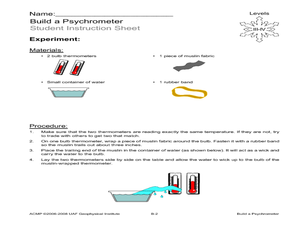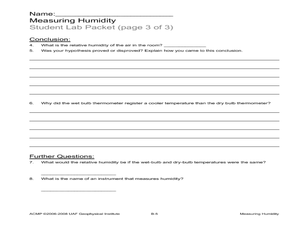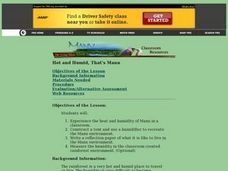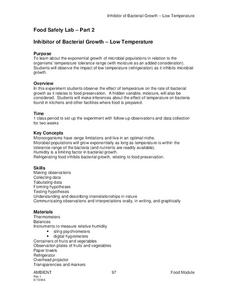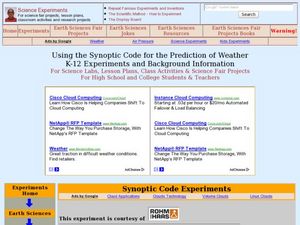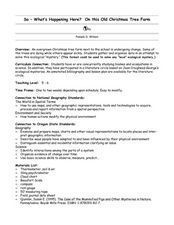Curated OER
Build a Psychrometer
Students understand that a psychrometer is a weather instrument used to detect humidity. In this psychrometer lesson, students build a psychrometer. Students use their psychrometers to measure humidity activity.
Curated OER
Weather Instruments
Middle school meteorologists get acquainted with basic weather instruments: the thermometer, barometer, psychrometer, and anemometer. For each, the question is asked, "Do you think you can make a _______________?" At these points, you...
Curated OER
Measuring Humidity
Students measure humidity in the classroom. For this weather lesson, students use a psychrometer to measure the humidity in the classroom. Students complete a lab packet.
Curated OER
Building a Psychrometer
Students create psychrometers to measure the humidity of the air. In this meteorology lesson, students make a wet-bulb thermomter and place it next to a dry-bulb thermometer to measure the relative humidity in the room.
Curated OER
Build Your Own Sling Psychrometer
High schoolers construct a sling psychrometer and they measure the relative amount of humidity in the air. They create their own experiment on how to construct a sling psychrometer and how they are going to measure the relative humidity...
Curated OER
Measuring Relative Humidity: A Psychrometer
In this scientific investigation worksheet, students follow the provided procedures to examine the temperature reading of wet and dry thermometers and then respond to 5 questions.
Curated OER
Relative Humidity of Your School
Pupils predict the location where the relative humidity the highest and lowest in and around their school. They use a sling psychrometer to measure the relative humidity of the various locations.
Curated OER
Hot and Humid, That's Manu
Elementary and middle schoolers participate in a demonstration of the heat and humidity of the Manu rainforest environment. They watch and discuss a video, calculate the humidity and temperature in the humidified tent, and write a...
Curated OER
Using the Synoptic Code for the Prediction of Weather
Young scholars interpret the synoptic code. They construct a thermoscreen with an anemometer. Students identify different types of clouds and understand and read barometric pressure. Young scholars predict weather pattern as they apply...
Curated OER
Food Safety Lab
Students use the scientific method to investigate the role of temperature in microbial growth. In this food preservation lesson plan, students set up an experiment with fruit in room temperature and in a refrigerator. They record the...
Curated OER
Using the Synoptic Code for the Prediction of Water
Students construct a thermoscreen for the experiment. For this earth science lesson, students make observations and interpret them using synoptic codes. They predict the weather based on gathered information.
Curated OER
Measuring Water Vapor: The Microwave Water Radiometer (MWR)
Students investigate water vapor. They view and analyze photos, conduct Internet research, and analyze the total water vapor/total liquid water data plot.
Curated OER
So -- What's Happening Here, On This Old Christmas Tree Farm?
Learners review their prior knowledge on biomes and ecosystems. At a local Christmas tree farm, they work together in groups to identify the changes occuring in the area. They participate in solving a mystery in which they determine the...
Curated OER
Weather Prediction
In this weather activity, high schoolers review vocabulary words and concepts associated with predicting the weather. Students understand what a meteorologist studies. This activity has 7 matching, 10 fill in the blank, and 5 short...
Curated OER
How Do Weather Conditions and Lunar Cycles Affect Fishing Success?
Middle schoolers use weather measuring devices to record and study weather conditions at different locations, during different times. They attempt to draw conclusions about the relationship between weather conditions, lunar cycle and...
Curated OER
So -- What's Happening Here? On this Old Christmas Tree Farm
Students take a field trip to an old Christmas tree farm near their school. In groups, they gather data at the site and analyze the data in an attempt to discover what happened to the area. They identify human activities that led to the...
Curated OER
Student Weather Journal
Students recognize different types of cloud patterns and associate these patterns with certain types of weather. They predict the weather for the next 6 to 24 hours. They then improve their observation skills as they check on the weather...
Curated OER
Introduction to Weather
Students explore the concepts of weather. They investigate lightening formation, construct weather maps and evaluate weather monitoring equipment. Students examine careers related to meteorology.
Curated OER
Succession and Experimental Process
Students describe the roles of controlled, manipulated and responding variables in scientific research. They also identify biotic and abiotic interactions affecting the makeup of a plant community.
Curated OER
Science Word Search
In this science instructional activity, students locate and identify various vocabulary terms related to earth science. There are 44 words/phrases located in the puzzle.
Curated OER
Build Your Own Weather Station
Studens experiment with temperatures. For this science lesson, young scholars make their own weather station by heating one bottle and keeping the water in another bottle at room temperature.


